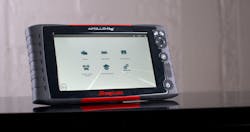When diagnosing a vehicle, the quicker it is to set up and complete a full system scan for technicians, the better. Tool reviewer Chad Austin, lead diagnostic technician at Austin Automotive in Canon City, Colorado, was impressed by how fast the Snap-on Apollo D9 scan tool functioned.
“[The Apollo D9 has] almost instant boot-up and a much faster full system scan compared to other brands and previous versions from Snap-on,” Austin says. “[The] automatic ID process begins when the scan tool is connected to the car, so there are less buttons to press to get connected.”
Austin uses the Apollo D9 in his shop mainly for full system scans, engine data PIDs, and reset procedures after a repair has been performed. He also uses it regularly for functional tests, reset adaptions, reset maintenance reminders, and looking up oil specifications.
The scan tool’s ability to look up oil specifications and service interval resets is also ideal for lube technicians. This makes it easy to ensure the proper fluids are being used, and that the customer doesn’t return with a maintenance light still on, Austin notes.
When the scan tool arrived, it came in a soft case with a power cable and OBD-II cable. Austin didn’t bother to look for a manual (even though it was included). The tool has a built-in help section and embedded videos to help with setup though, he adds.
For the most part, the scan tool is ready to use right out of the box. There are just a few features that require online registration prior to use, such as FCA secure gateway access and Altus, Snap-on’s cloud file sharing site.
“I think it’s one of the most user-friendly scan tools available,” Austin notes. “Even a new user should be able to figure out the basics without any guidance.”
Austin has used nearly all previous Snap-on scan tools, whether in his own shop or others’. He likes the new larger 9” screen and improved touch sensitivity that allows scrolling with a swipe of a finger instead of tapping buttons up and/or down.
Along with how fast the scan tool functions, its included Snap-on Cloud is another favorite feature. Austin likes how the scan tool automatically saves full system scans to Snap-on’s Cloud and includes keywords to make it easier to search for at a later time, if needed. It’s also easier to print and email from.
As far as a way to improve the Apollo D9, Austin says a wireless scan module such as the one found on the Snap-on Zeus and Verus scan tools is a good idea. However, he believes it isn’t really needed.
Overall, the Snap-on Apollo D9 scan tool was easy to use and its speed won this diagnostic technician over.
The Snap-on Apollo D9 is designed to provide technicians with a diagnostic tool that helps them get the job done. It offers access to Intelligent Diagnostics for filtered codes and vehicle specific data that’s constantly updated for quick and confident repairs. APOLLO-D9 features a four-way thumb pad for quick navigation, a 9" capacitive color touchscreen display, and 5 GHz wireless compatibility. Its fast boot-up, as well as one-touch code scan and clear, enables technicians to move quickly from start to print. It also offers advanced graphing features and OEM-level data, along with OEM-specific scanner coverage for over 49 Asian, domestic, and European makes and over 100 vehicle systems.
About the Author
Kayla Nadler
Associate Editor | Vehicle Repair Group
Kayla (Oschmann) Nadler was previously an associate editor for the Vehicle Repair Group.
With an education in journalism and public relations, Nadler contributed to Professional Tool & Equipment News (PTEN) and Professional Distributor magazines, as well as VehicleServicePros.com.

